How to choose what currency to trade today? You can use the trading calendar and look for impactful events to find an instrument to trade. Also, technical analysis may give you hints about promising assets. That’s not all, though, and in this article, you will know about currency strength and how to make your trading more data-driven with this simple indicator.
From this article, you will know what is currency strength, Currency Strength Meter (CSM), how to calculate currency strength, and how to use it with various analysis types. Examples will help you understand the topic better and start using new knowledge right after the reading.
Key takeaways
- Currency strength measures the relative power of one currency compared to another and affects exchange rates.
- A currency Strength Meter (CSM) is a tool used to measure the strength of individual currencies via fundamental factors or relative movements of one currency to another.
- Currency strength is calculated based on fundamental data or price data.
- Currency strength serves as a valuable economic indicator that provides insight into a country's financial health and economic stability. Banks use this data to make decisions on monetary policy.
- Technical analysts use currency strength indicators to identify trends in the forex market.
What is Currency Strength?
Currency strength measures the relative power of one currency compared to another and affects exchange rates. A strong currency has high demand, grows in value, and has a stable economy while a weak currency declines in value and is associated with an unstable economy.
You can think of currency strength as an indicator that reflects various factors related to a currency, such as fundamental data, overall economic performance, and interest rates. To calculate it, one usually compares the currency to other currencies using a predefined basket, such as the US Dollar Index (DXY). You can read more about the US Dollar Index on our Telegram channel.
What Is A Currency Strength Meter (CSM)
A currency Strength Meter (CSM) is a tool used to measure the strength of individual currencies. A CSM displays the relative strength of each currency in real-time, allowing traders and investors to quickly identify which currencies are strengthening or weakening.
It typically shows the strength of each currency on a scale of 0 to 10, with higher numbers indicating a stronger currency. CSM can be used in a variety of ways, such as determining which currency pairs to trade or as a signal for entering and exiting trades. In the next section, we will delve into how the strength of a currency is calculated and used as an economic indicator.
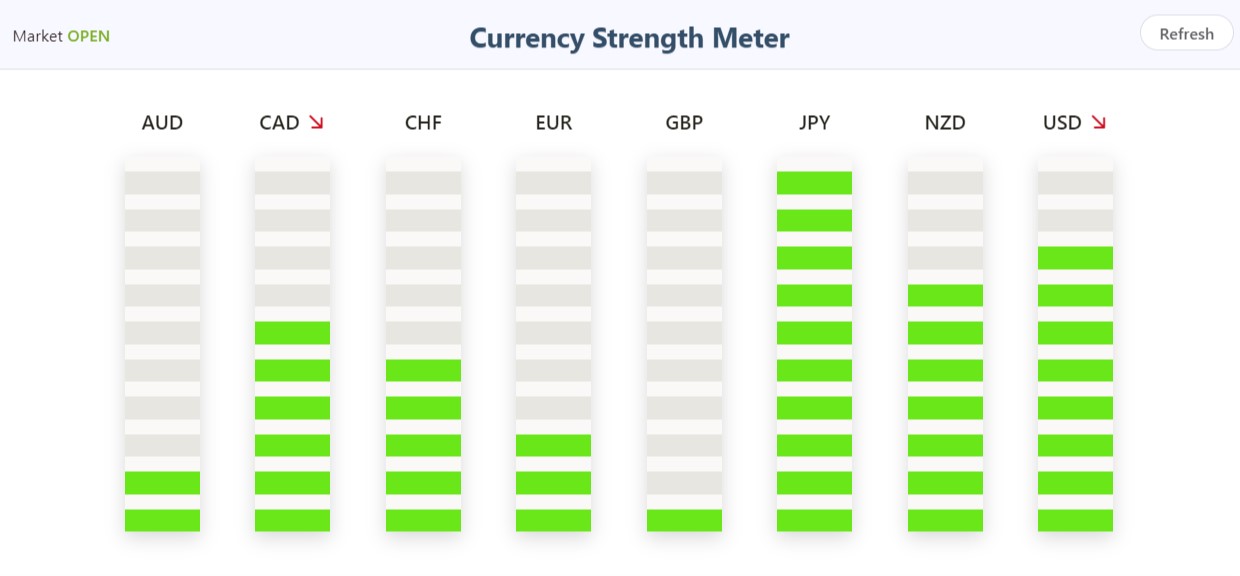
Source: https://currencystrengthmeter.org/
How to Calculate the Currency Strength?
There are two types of currency strength calculations: based on fundamental or price data. Generally, price-based currency strength is calculated from the DXY (the US dollar index), which is a reference for other currency indices. If some currency pair (let’s say NZDUSD) is in an uptrend, you are able to determine whether this happens due to NZD strength or USD weakness. To calculate the indicator, major currencies are usually used because they represent up to 90% of the whole Forex market volume.
The calculation based on fundamentals is measured by aggregating various leading economic reports, like GDP, PMI, CPI, and interest rates. You can watch these data in real-time with our economic calendar.
Although a trader might calculate the currency strength by themselves, traders don’t usually analyze currency strength by hand, they use CSM instead. The Currency Strength Meter compares every cross between major currencies (USD, GBP, EUR, CHF, JPY, CAD, NZD, and AUD) and comes up with a relative currency strength.
The calculation method varies, but often involves weighing the factors, creating an index, and normalizing the results to a scale of 0 to 10. However, the subjective nature of the calculation means that it can vary depending on the method and data sources used. Nevertheless, currency strength meters offer a real-time perspective, thus, helping traders perform better.
Companies make their own currency strength meters that display the relative strength of each currency for the last 24 hours. Sometimes they show each currency against another currency, essentially just showing you how each currency pair is doing. Others combine all the pairs associated with a currency to come up with an overall strength of a currency. The information is usually presented in a “heat map” format, or sometimes in the form of a line graph. An example of such a meter is below.
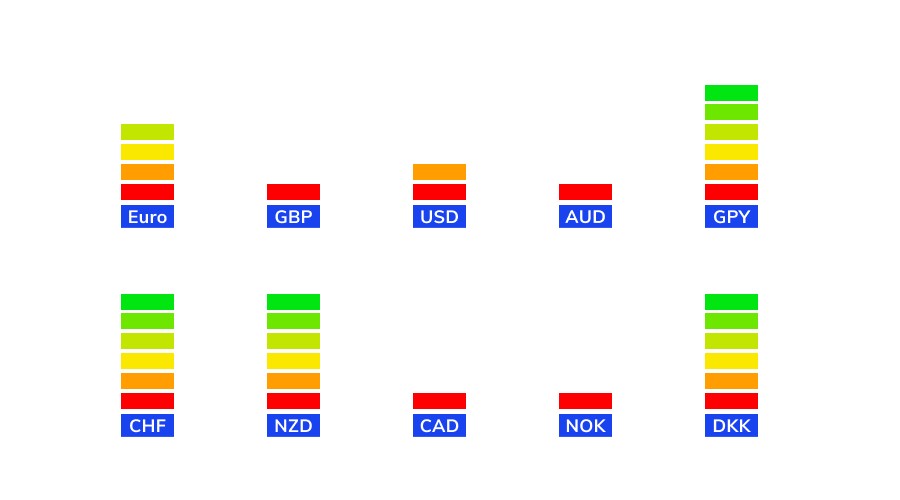
Currency strength in a form of a “Heat map”
Currency Strength as an Economic Indicator
Currency strength serves as a valuable economic indicator that provides insight into a country's financial health and economic stability. A strong currency is typically associated with a stable economy, low inflation, and interest rates, which are attractive to foreign investors and traders. On the other hand, a weak currency is often associated with economic instability, high inflation, and interest rates. For example, if a country's currency is weak, it may indicate that the country is facing economic turmoil deterring foreign investment.
Understanding the strength of a currency can provide valuable information for central banks that use this data to adjust risks and exchange rates. Currency strength is a critical factor for anyone actively participating in the foreign exchange market because it shows us what is actually happening between different currencies.
Sometimes, currency strength can show long-term trends that will greatly affect the world’s economy. Every advanced forex trader uses currency strength in their trading strategies, even if they don’t actually open the CSM. An intuitive understanding of currency strength is still important for market participants.
Currency Strength Indicators in Technical Analysis
Technical analysts use currency strength indicators to identify trends in the forex market. There are various methods for measuring currency strength, including absolute currency strength (ACS) and relative currency strength (RCS).
Absolute Currency Strength (ACS)
Absolute Currency Strength (ACS) assigns a value to each currency based on its own strength, without considering its relationship to other currencies. For example, a high value for the US dollar in an ACS measurement would indicate that the US dollar is strong, regardless of its relative strength to other currencies.
Traders use various indicators, such as economic data, central bank policies, political stability, and investor sentiment to calculate the ACS value. The higher the value, the stronger the currency.
Relative Currency Strength (RCS)
On the other hand, Relative Currency Strength (RCS) measures the strength of one currency relative to another. For example, if the GBP is strong relative to the AUD, the RCS value for the GBP will be higher than that for the AUD.
To calculate RCS, traders (or companies) plot the exchange rates through various formulas and calculate the difference. If the first currency's exchange rate is higher than the second currency, it shows that the first currency is stronger. Otherwise, the second currency is stronger.
Technical analysts often use currency strength indicators and other technical indicators, such as trend lines and moving averages, to identify currency trends.
In conclusion, currency strength indicators in technical analysis are valuable in different ways. While relative strength help traders compare two currencies, absolute strength points to the overall state of the market.
How to Trade with Currency Strength?
Trading with currency strength involves several steps. First, a trader looks at the currency strength meter to identify what to trade and in which direction. Then, a trader can use several strategies to take advantage of currency strength, for example:
1. Pair Trading: This involves trading currency pairs where the stronger currency is paired with the weaker currency. For example, if the US dollar is strong and the euro is weak, a trader might sell the EURUSD pair.
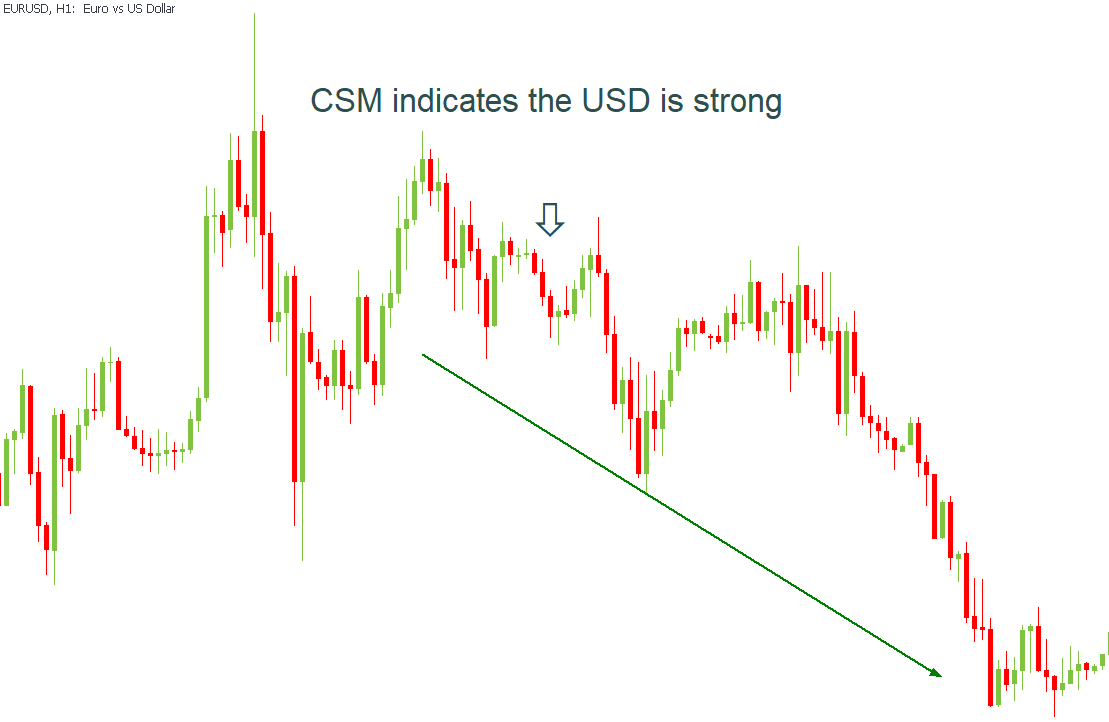
2. Positive Correlation Trading: In this strategy, a trader needs to find two currency pairs that move in the same direction and trade them both in the same direction. For example, if the AUDUSD and EURUSD are positively correlated, a trader might sell both currency pairs when the US dollar is strong.
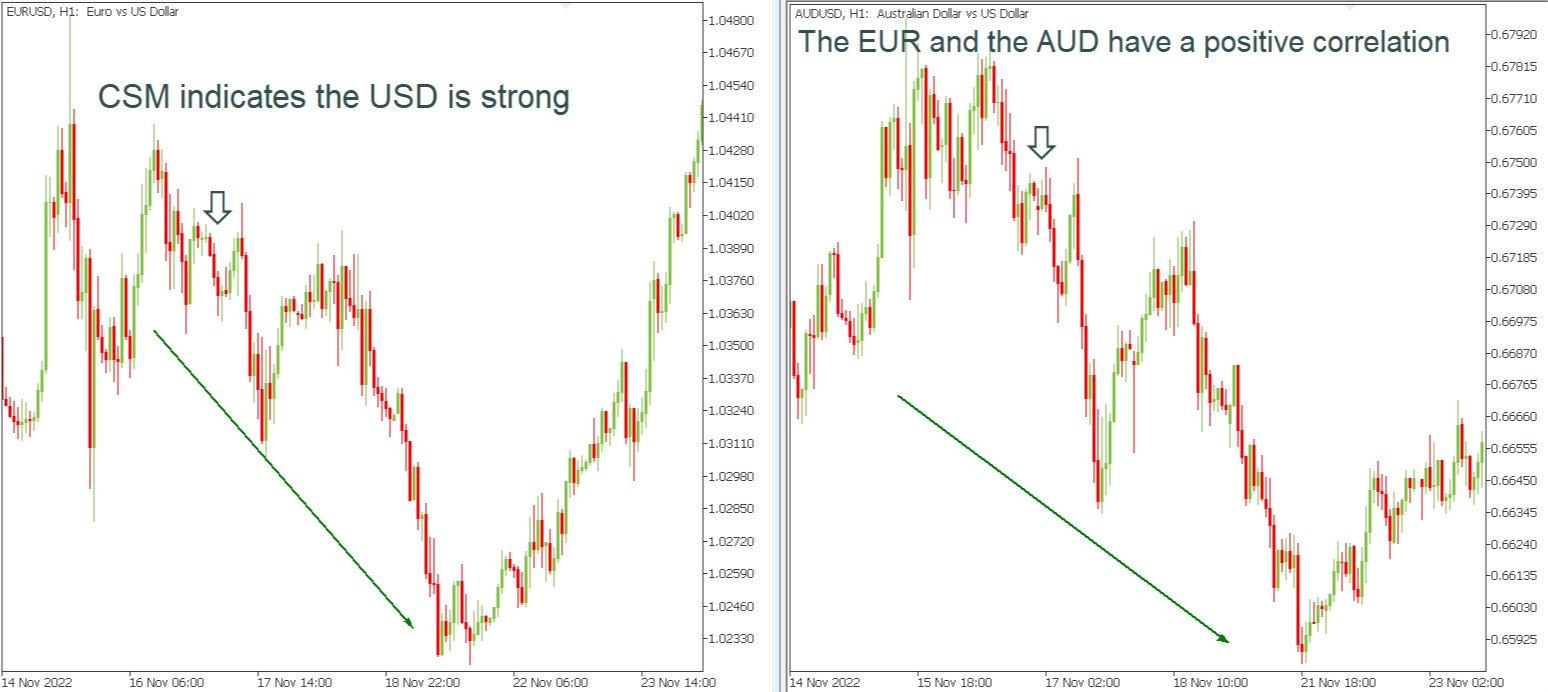
3. Negative Correlation Trading: A trader finds two pairs that move in opposite directions and trade them in opposite directions. For example, if the GBPUSD and EURUSD are negatively correlated, a trader might sell one currency pair while buying the other when the US dollar is strong.
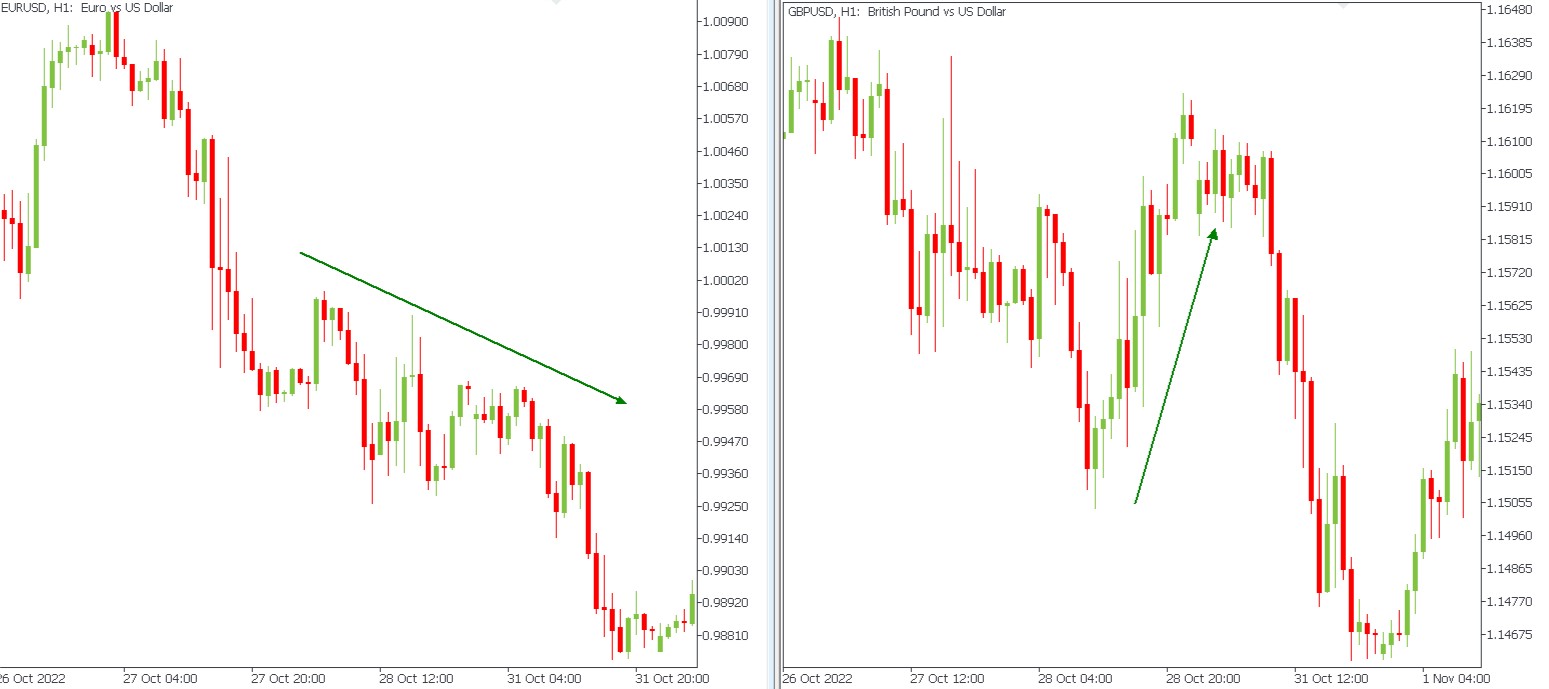
It's important to note that while currency strength can be a useful tool, it's not a guarantee of success. Traders should always consider multiple factors and have a risk management plan in place.
Why Trade Currency Strength Reports with TradeGlide
As a reputable forex broker, FBS allows you to trade dozens of different currency pairs, including all major currencies (USD, GBP, EUR, CHF, JPY, CAD, NZD, and AUD), plus exotic currencies such as TRY, CNH, SGD, and MXN.
By looking at the CSM you can decide whether to buy or sell some specific pair. With FBS you can take the most out of your decision, place an order that will be executed insanely fast, and benefit from tight spreads and a great range of trading instruments.
Currency strength is a critical factor for anyone participating in the forex market and can provide valuable information on a country's economic stability and financial health. Traders can make data-driven decisions and improve their trading performance with this tool. Technical analysts can also use the strength indicator to identify trends in the market.
Get ahead of the competition by incorporating currency strength into your trading strategies!








No comments:
Post a Comment